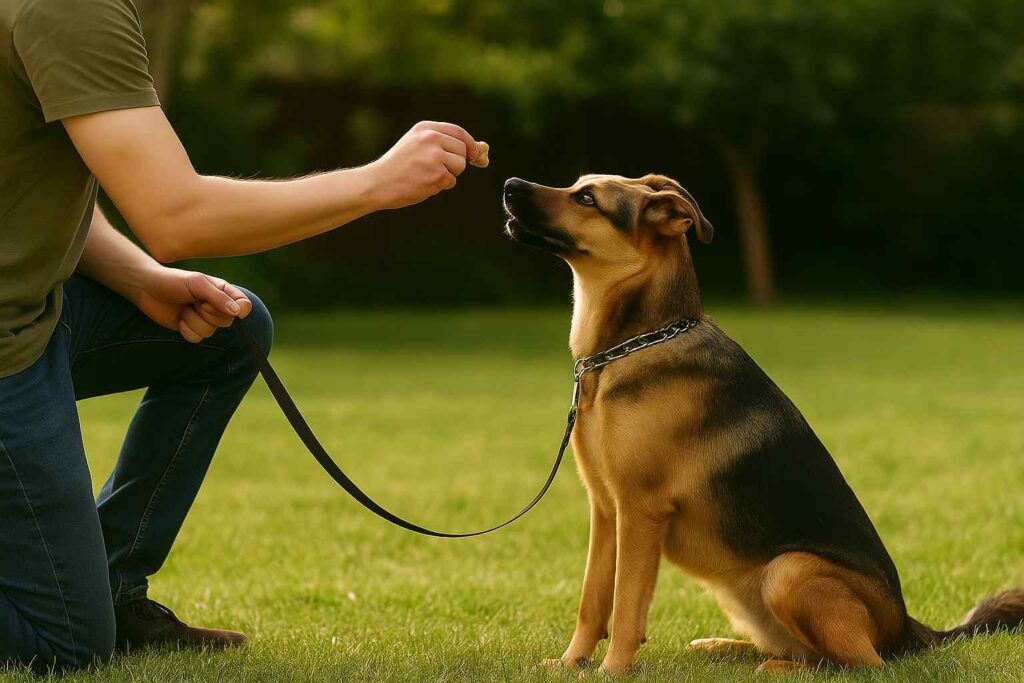If you’ve ever seen a prong collar and immediately thought, “That looks scary,” you’re not alone. Prong collars are one of the most debated training tools in the dog world. Some swear by them, others strongly oppose them. But like many things in life, the truth lies somewhere in the middle.
As a dog owner, your number one priority is your pet’s well-being and that includes finding tools that work safely and effectively. This blog aims to give you a full, balanced guide to prong collars: what they are, what they do, how to use them (if you choose to), and what to consider before making that decision.
1. What Is a Prong Collar? (Explained Simply)
A prong collar, also known as a pinch collar, is a dog training tool made of metal links with blunted prongs that face inward toward the dog’s neck. It tightens slightly when pressure is applied, like when your dog pulls, and loosens when the dog stops pulling. The intention is to mimic the natural correction a dog might receive from its mother or another dog.
It appears intense, but when properly sized and used, it distributes pressure evenly around the dog’s neck and is designed to prevent injury. Still, it requires careful use and an understanding of how it works.
2. What Are Prong Collars Used For?
Prong collars are often used for dogs that pull excessively on the leash, are reactive toward other dogs or people, or are simply too strong for their handler to manage safely. They are especially common in professional training settings, including obedience and protection work.
The goal isn’t to hurt or scare the dog, but to offer a correction that gets the dog’s attention and encourages better behavior. For some handlers, it’s the only tool that gives them the control they need in high-distraction environments.
3. How Do Prong Collars Work?
When the dog pulls on the leash, the prong collar tightens slightly and applies even pressure around the neck not in a choking manner, but more like a “tap on the shoulder” to get their attention. Once the pulling stops, the collar loosens. This clear on/off pressure helps dogs learn what behavior is being corrected.
Unlike a standard flat collar that can put pressure on the windpipe or cause tracheal damage, a properly fitted prong collar actually reduces injury risk by distributing pressure more evenly.
That said, it has to be placed high on the neck and fit snugly, not loose and sliding down like a necklace.
4. Benefits of Prong Collars (When Used Correctly)
- Control: They offer a high level of control, especially with large, strong, or reactive dogs.
- Safety for the Handler: They help prevent dogs from pulling owners into traffic or lunging at other dogs.
- Training Clarity: They provide quick, clear feedback to the dog.
- Reduced Strain: They reduce pressure on the dog’s trachea compared to a flat collar.
For many owners, prong collars are a short-term solution during the training process not a permanent everyday collar.
5. The Drawbacks & Risks of Prong Collars
- Misuse Can Cause Harm: If used incorrectly jerking, yanking, or using it on a fearful dog, it can cause pain or fear.
- Bad Associations: A dog can begin to associate the pain with other dogs, people, or situations.
- Not Ideal for All Dogs: Fearful, anxious, or very young dogs are not good candidates.
- Lack of Education: Many people use them without understanding how, which leads to misuse.
These collars are not magic. They’re not a replacement for training, patience, or relationship-building.
If you’re concerned about the potential discomfort of prong collars, you can go ahead and explore our list of trendy collars that are stylish yet comfortable.
6. Prong Collar Myths vs. Facts
| Myth | Fact |
| Prong collars are cruel. | They can be harmful if misused, but when used correctly, they offer safe and consistent feedback. |
| Only lazy trainers use prong collars. | Many certified trainers incorporate prong collars into well-rounded training programs, especially for large, reactive dogs. |
| A harness is always a better alternative. | Harnesses can encourage pulling in some dogs, especially without training. |
7. Are Prong Collars Bad for Dogs?
This is the big question, and the honest answer is: It depends on how they’re used.
A prong collar isn’t inherently bad. What matters is the handler’s intent, skill, and consistency. If used with harsh corrections, it can create fear or damage trust. If used gently and thoughtfully as part of a balanced approach, It can help some dogs learn leash manners faster and with less struggle.
Like any training tool, the prong collar is only as good (or bad) as the person using it.
8. Tips for Using a Prong Collar Safely
- Fit it high on the neck, just behind the ears.
- Use it snug, not loose.
- Don’t jerk or yank. Let the collar do the work.
- Pair it with rewards and praise.
- Supervise your dog and never leave the collar on when unsupervised.
- Start slow. Let your dog get used to it with short sessions.
Bonus tip: Try it on your own arm or leg to understand the sensation. It should feel firm, not painful.
9. Alternatives to Prong Collars
If a prong collar doesn’t feel right for you, there are other tools:
- Front-clip harnesses that redirect pulling
- Head halters like the Gentle Leader
- Martingale collars for dogs who slip out of flat collars
- Positive reinforcement techniques with treats and praise
Every dog is different, and your training tools should reflect your dog’s needs and temperament. Looking for alternatives to prong collars? Here are the best no-pull collars for daily walks.
Conclusion: Do What’s Right for Your Dog
If you’re considering a prong collar, it doesn’t mean you’re a bad dog owner. In fact, it means you care enough to look into what works. The key is using any tool, prong collar or not with knowledge, compassion, and a willingness to adapt.
There is no one-size-fits-all approach to dog training. What works for one dog may not work for another. But with patience, clear communication, and the right tools, you can absolutely build a better walking relationship with your dog.
Have you used a prong collar before? Share your experience in the comments or explore our other training guides to learn more.




